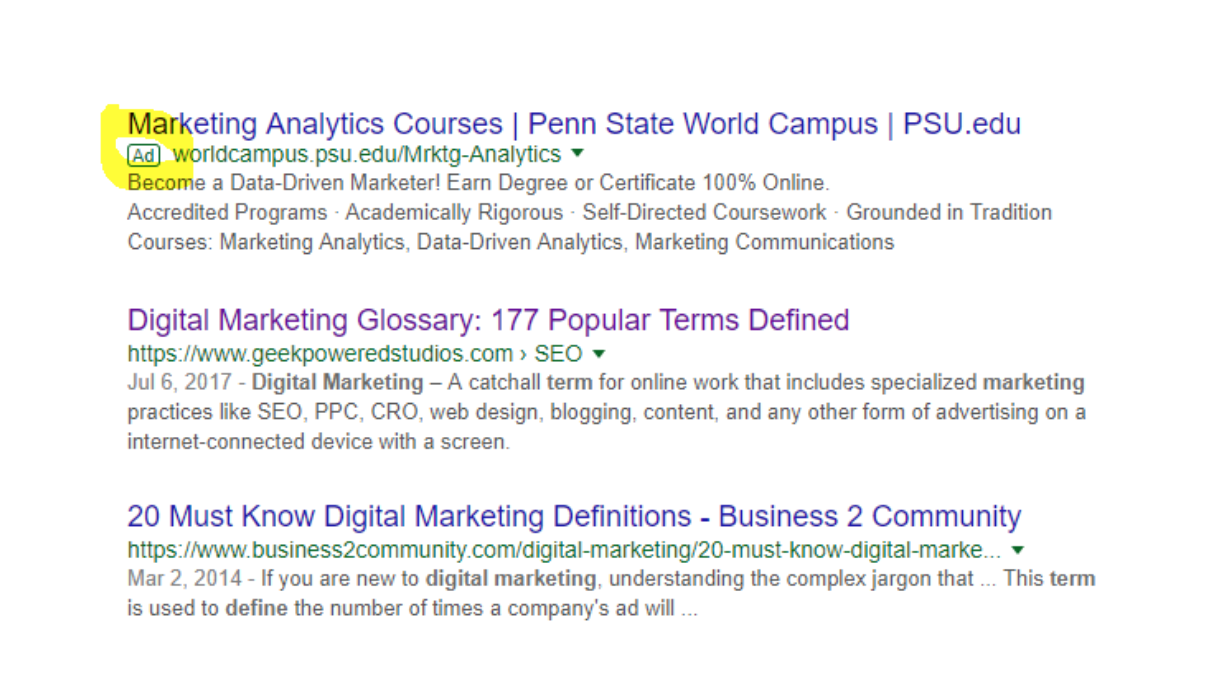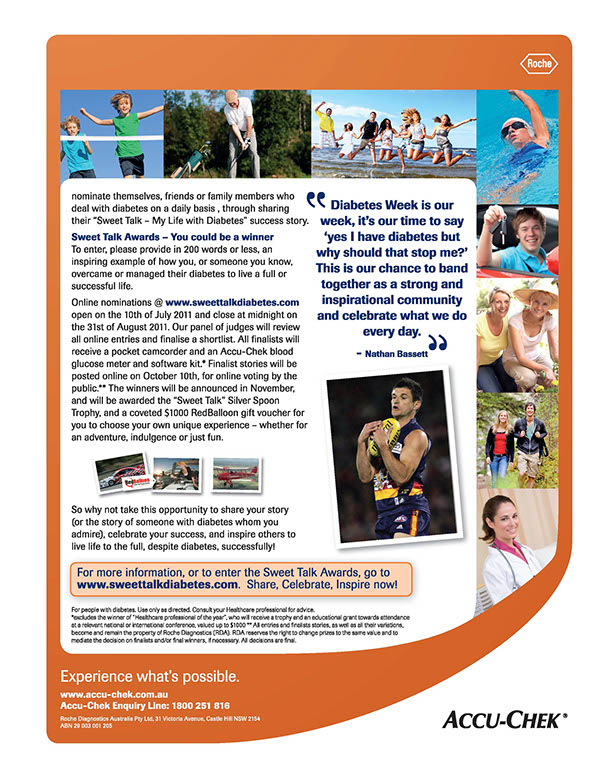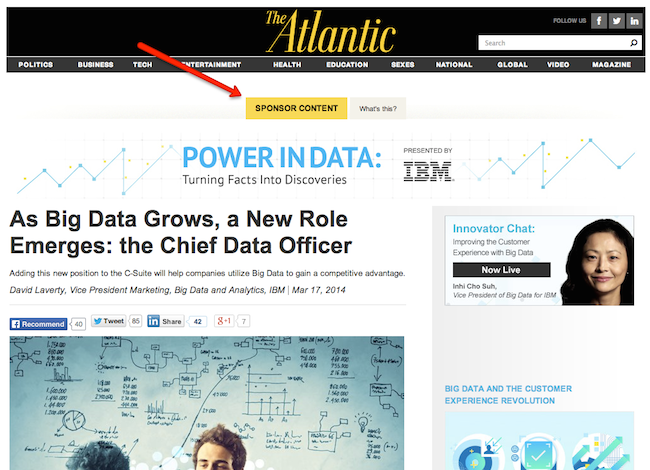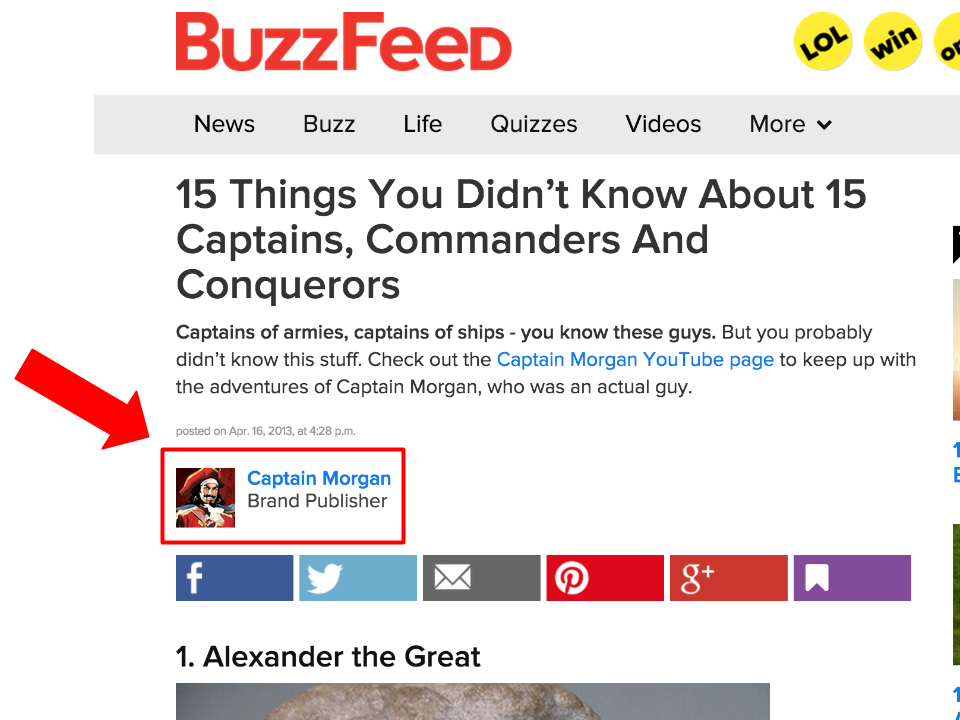Many marketers don’t know what native advertising is -- or if they have heard about it, they don’t know the difference between traditional advertisements and native ads. In fact, 49 percent of marketers don’t know what native advertising is, 24 percent are familiar, and 24 percent are only somewhat familiar (but it’s still fuzzy at best...).
That leaves us with only 3 percent of experts that are familiar with native advertising. The good news? Our go-to native advertising guide for beginners will help you unpack the intricacies of this marketing strategy and help you discover how it can grow your business.
Table of Contents
- What Is Native Advertising Exactly?
- How To Grow Your Business With Native Advertising
- The History Of Native Advertising
- Search Engine Native Advertising
- Native Advertising On Social Media
- In-Feed Native Ads
- Content Recommendations
- The Benefits Of Native Advertising
- The Difference Between Native Advertising And An Advertorial
- What Problems Does Native Advertising Face Today?
- Native Advertising And The Future Of Content
What Is Native Advertising Exactly?
The official definition is that native advertising is that the ad cohesively matches the form and function of on the platform on which it’s displayed.
We know - it sounds confusing and vague, but this breakdown might help. A native advertisement adapts to the platforms, so if you have an online publication with blogs, the native advertisement would be a blog post, written and displayed so that it looks exactly like all other blog posts on that website, apart from the simple fact that you can find a note somewhere that it has been sponsored by an external brand.
There are several types of native ads, and they can be segmented according to the place they originate from and the platforms on which they can be found.
How To Grow Your Business With Native Advertising
- Label Your Native Ads
- Be A Guest Blogger
- Pay Others To Write For You
- Experiment With Different Native Ad Formats
- Choose The Best Headline
- Be Informative
- Match The Style And Form
- Sell, But Don't Underdeliver
- Guide The Consumers Of Content
- Retarget Users Who Engaged With Native Ads
The studies show that, despite the intricacies, native advertising works. And since we are offering a complete guide to native advertising, we will explore how to use native advertising to increase your return on investment and click-through rates.
1. Label Your Native Ads
Make sure you mark any native advertisements as sponsored posts (or whatever the appropriate label is). You need to maintain integrity to ensure your consumers don't feel deceived.
This rings true especially if you are new to creating content. In the first couple of native ads you place, you might create the wrong balance of selling and pitching, so having a clear label definitely lets you play a bit loosely with the rules. Just remember -- until you strike the right balance, you won't quite be writing a native ad piece, but a content marketing article. However, proper labels keep your brand honest and trustworthy and give you time to master the learning curve without alienating consumers.
2. Be A Guest Blogger
You can promote your products or services by finding opportunities to promote your expertise and content on other people’s blogs. In addition, you can use sites like SEMrush to become a contributor, writing your own native advertising piece and building authority within your target demographic and industry. This tactic is also great for SEO purposes by increasing link building from a major publication with a great online reputation.
Pro Tip: Sites like SEMrush are very protective of their space and the value they provide, so they will be very critical of the work you submit for approval. Make sure you aren’t overly promotional and provide important information.
3. Pay Others To Write For You
Publishers wouldn’t be where they are if they didn’t know their way around successful content marketing tools and writing native advertisements. They are the experts, after all. Plus, learn how to create an effective content marketing strategy with DesignRush's comprehensive guide.
4. Experiment With Different Native Ad Formats
Maybe an in-feed native ad is the right choice for your business, perhaps you can achieve success with some paid search results, or you can promote more of your already written content with simple content recommendations. There are tons of native ad options, you just need to find the one that works for your brand AND business goals.
5. Choose The Best Headline
The headline is arguably the most important part of a piece of published content. It sets the tone for the rest of the article and encourages people to read your native ad -- or any type of content you create. Unfortunately, it's also why the recently popular clickbait headlines have worked so well.
But don't be like cheap clickbait -- not only is it shallow, but research shows that clickbait articles anger consumers. Plus, people might click on those links, but often leave abruptly, ultimately harming your search engine rankings and optimization. Your on-page time will decrease, your bounce rate will increase, and that will flag the content as undesirable to search engines. So, don’t do click bait – write powerful, engaging headlines instead.
A good rule of thumb when you’re having doubts about your headlines is to think about writing it simply for social media. Try something short, sweet and to the point that accurately describes the article. Then, include an adjective and an active-voice verb.
6. Be Informative
Educate readers and provide real value that will be interesting enough to drive the engagement even further. Within your content, offer real tips and insights into a subject and, in general, write high-quality content so that people will feel satisfied with the read, and the “gain,” in terms of added value. Stumped? Try topics like how-to guides and tips and tricks, because that type of content has a high conversion rate. For instance, North Americans alone have watched more than 100 million hours of how-to content.
7. Match The Style And Form
In order to create a successful native advertisement, you have to match the style and format of a publication. Even though the labeling should clearly state that the post is sponsored, every other design, layout, topic, and tone of voice choice should subconsciously counteract that, enabling the user to perceive this paid ad as the regular content piece on that publisher’s website.
8. Sell, But Don't Underdeliver
This statement is true for the content and the headline as well. You have to walk the line carefully here – if you miss out on pointing out what you will bring to the table with your native ad content piece, people might not click it, read it, or comprehend it. But if you go overboard, overpromise, and underdeliver, you will be leaving a lot of content consumers unsatisfied – you can risk losing their trust and long-term business. Market your piece at the exact right amount of value provided.
9. Guide The Consumers Of Content
Whether it’s a video or a written native advert, learn how to guide the content consumers and ease them into an ad placement. If you do it too soon, you will lose their interest and your credibility. If it’s not relevant or if people can’t accept it as part of the natural flow of the content, then you executed the project poorly and need to reevaluate your approach to consumers. Remember, native ads are called native because they also have to be natural. Don’t try to force the ad.
Friskies does this nicely with the “Dear Kitten” video – this is a great example of a native ad that went viral because of its content, and not because people were enamored with the ad. Actually, despite the fact that there is just one single line about Friskies in the entire three-minute video, it is still highly converting. See how they build up and develop the idea? And put the Friskies food at the point where you are already drawn into the video, and you don’t actually mind the promotional content. This video brought massive engagement for the Friskies brand and was viewed more than 30 million times on YouTube.
Lucky for Friskies, they had some publisher help – this is a BuzzFeed video, and after its huge success, Friskies and BuzzFeed together created several more videos in the same format.
10. Retarget Users Who Engaged With Native Ads
Since native ads are responsible for a much higher click-through rate than banner ads, you can use retargeting to achieve better results with display ads. Because the users are already engaged with the native ad, they will be more receptive towards the display ad. This is due to the fact that engaging with a native ad headline brings 308 times better customer attention, as opposed to processing images or banners. A processed image might bring instant gratification, but a native advertisement will be impressed in their minds, ensuring consumers think about the product more and remember it with more clarity.
The History Of Native Advertising
At the beginning of Internet advertising, we had web banners. And for a while, they worked. But then, people started developing something that’s called banner blindness. Banners initially worked because they attracted attention with their flashy design. We all remember those blinking abominations that adorned the web 1.0 websites back in the day. But then, as time passed, and our brains got accustomed to the non-interesting ads and their placement on the websites, we evolved to the point where we didn’t even notice them. Look at these statistics about the average click-through rate (CTR) decline over the years.
And then came the popup. When people stopped noticing traditional banners, one step up was to interrupt their browsing and pester them with popups. This trend then evolved again into hiding the "X" buttons so that you have to look closely, essentially playing "Where's Waldo" just so you can close the popup window. Thus, marketers understood that they had to find a new form of marketing and displaying paid content that would actually work.
Search Engine Native Advertising
One of the most commonly spotted forms of native ads comes on search engine result pages. When we view the first page of search results, the first ones are almost always paid ads, but overall, they look the same as every other search result on the page. Check out this excellent example of a native search engine advertisement.

As you can see, the only difference between the first search results and the second and third is a small “Ad” label. The snippet otherwise remains the same as organic options below, including the amount of text, the layout and the overall call to action and goal of the search result. If you weren’t familiar with Google’s paid ads, you probably wouldn’t notice that there’s a difference, particularly between the titles, URLs, and copy.
Native Advertising On Social Media
A native advertisement can be placed on social media as well, where it would take on a form of a regular post. The posts on Twitter, Facebook, and Pinterest even can be labeled as sponsored within the caption, content, or location stamp, but overall, the general feel of sponsored social posts isn't that of a typical advertisement. If it were, you would clearly see it’s an ad, and it wouldn't be doing its native advertisement duty of blending into the form of the medium it is presented on.
For example, one post could promote social media marketing services on Facebook and outrightly target people who might need it, like small businesses. The paid ad and the copy definitely look like an ad, and no one would mistake it for something else -- “Hire us for your social media marketing needs, just click the link below to see our offer.” But if you had a basic feed on any social media platform, and have a post that says something like, “10 ways small businesses can supercharge their social media presence,” you expect an article that will deliver that exact value. While the article will deliver valuable content, because it is a native advertisement, it will also contain links and mentions to a specific agency's offerings as well.
The same idea goes for Twitter, Instagram, and Pinterest’s promoted posts – they look like regular posts, but there’s a label stating otherwise, enabling them to appear authentic and organic while subtly marketing a business, product or service.
In-Feed Native Ads
In-feed native advertising means that the ad was placed natively in the feed. This is exactly what we do at DesignRush by adding relevant links to our blog posts about the topics closely related to the subject we are writing about. For example, here we could state how we also have a complete guide to the best social media tools you can use to grow your brand (see what we did there?). It’s relevant because we are placing it in the paragraph where we discuss social media, making it a logical choice for the reader and a topic that they might be interested in learning about without raising any promotional red flags.
In-feed native advertising can also be found in video feeds – you know how actors in the movies drink Coca-Cola, or how Woodie Harrelson (playing Tallahassee) obsessively searched for Twinkies in Zombieland? That is product placement at its best, and because it’s so embedded in the movie’s storyline, it’s a wonderful example of a native ad.
Content Recommendations
If you read a piece, or watch a video, and see some recommendations for the next content you can consume, that is also native advertising. It isn’t pushy, it comes as a natural addition to the previous content, and it actually might interest the user. The same goes for YouTube videos – whenever you finish watching a video, YouTube will recommend other videos to you that are in the same vein as the content you just watched.
The Benefits Of Native Advertising
As you have probably gathered so far, native advertising works because you don’t feel as though it’s advertising at all. The content may promote a product or a service, but it won’t oversell or annoy readers – the content itself will be very natural and authentic.
The biggest advantage of native advertising is its ability to tease and flirt with the consumers of content, without them dismissing the information like they would traditional ads. With native ads, users actually pay attention -- and according to the research, that is because people really do think they are reading an editorial content piece – they look at native ads 2 percent more than editorials, and spend the same amount of time reading them.
People see native ads 25 percent more than traditional banners, which consequently translates to more clicks and a better return on investment (ROI). Also, native ads are better at driving purchases – 18 percent better than banners, to be exact. Actually, banner ads are so obsolete – it’s statistically 475 times more likely to survive a plane crash than to click on a banner (yikes...). But in case you are wondering why anybody still uses them, they are still a great tool for increasing brand recognition and visibility, and can even help in the consideration phase of the buyer’s journey.
Even though we said many marketers don’t really understand the power of native advertising, the publishers, on the other hand, do. And naturally, because they are the ones getting paid to promote that content, we are seeing a rising trend and interest for native ads – nearly 90 percent of publishers have native advertising campaigns in motion or plan to launch them in the near future.
The Difference Between Native Advertising And An Advertorial
Let’s take newspapers for example – you have editorial pieces that you are accustomed to, and you love reading them. So, if you take a certain print media or online publication, you will quickly grasp its overarching format, tone, style and the type of content they create. Now, advertorials will conform to some, or even most of those parameters. However, it will still be clear that the content in question is ultimately an ad endorsed by a brand. This Roche Pharma's article is a great and clear-cut example of an advertorial:

It’s in print form, and clearly outlines who the creator is and the brand behind the article. It makes no bones about outwardly promoting Roche Pharma, and provides added value for the readers since these are published in medical journals and health magazines. This one is even branded with the company’s signature blue color on a white background.
On the other hand, this is a typical example of native advertising:

The Atlantic has executed native advertising splendidly. The headline is inconspicuous and well, notbranded. The topic, on its own, has nothing to do with the Dell brand. Meanwhile, the content of the article is also closely in line with The Atlantic’s general reporting and coverage, and is formatted similarly to the other articles., formatting is the same like in their other articles. There is only one label that acknowledges that the content is sponsored. You can read the article here, and see that the only way it’s tied to IBM is through the header, where we see that the contributor works at IBM and that the article includes a few -- albeit valuable -- links to IBM's website.
Conversely, Buzzfeed shows us an unexpected example of an advertorial. Notice how the headline, author name, bio and content all point to the same calls to action and serve the same information. This is a striking example of a blatant advertorial content.

So, is an advertorial considered to be native advertising? No. And here’s why: Advertorials have branded content, clear calls to action, and they can try to mimic native advertising, but if they are promotional to the point where content consumers can clearly see it’s an adv, then it is, well, an ad. With native advertising, people don’t feel forced to do something or complete an action -- nor are they asked to. They have freedom of choice, as they would in any authentic content across the Internet.
What Problems Does Native Advertising Face Today?
There are some indications that, while native advertising can prove to be a great investment, perhaps it won’t be sustainable in the long-term. Just like banner blindness came to be, so people might start to feel unfazed by native ads.
There are also instances of people losing faith in the brand that’s promoted, poorly labels content, or is too over the top when it comes to pitching, selling and pushing products. In fact, nearly 54 percent of consumers don't trust brands who produce branded or sponsored content, proving that native advertising is a tricky line to tow.
But it doesn’t stop there. People may also mistrust the publisher who ran the content piece. Additionally, ad blockers are also threatening the expansion of native advertising, as they are slowly evolving to recognize sponsored ad content on publisher sites.
Don’t be discouraged, though – now is the golden age of native advertising, so long as it is not being overused. The strategy still brings plenty of return on investment and strong click-through rates to businesses who are looking to expand their outreach.
Native Advertising And The Future Of Content
Native advertising is currently expanding, and both marketers and publishers will definitely invest more time and money in it in the future because it ultimately does provide strong results. However, it remains to be seen how ad blockers will shape the future of native advertising – maybe they are the ones that will be spared?
But presently, native advertising brings more revenue and results per dollar invested. According to the Native Advertising Institute, by 2021, native advertising will be responsible for driving 74 percent of all ad revenue, and total spending on native ads clocked in at about $21 billion by the end of 2018. Those trends are on a steady rise, proving that it will be worth your while to begin investing in a native advertising strategy, stat.








